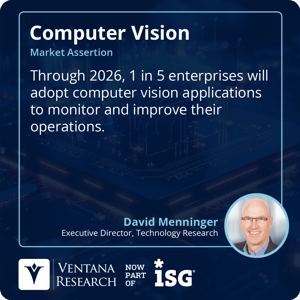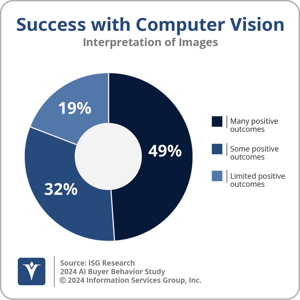Unstructured data has been a significant factor in data lakes and analytics for some time. Twelve years ago, nearly a third of enterprises were working with large amounts of unstructured data. As I’ve pointed out previously, unstructured data is really a misnomer. The data is structured; it's just not structured into rows and columns that fit neatly into a relational table like much of the other information enterprises process. Consequently, it requires different skills, different technology and more computing power to process this data. Our Analytics and Data Benchmark Research shows that nearly 6 in 10 enterprises (59%) have inadequate unstructured data management technology. A similar percentage (58%) had inadequate training in analyzing unstructured data. However, as computing power increases and the cost of storage decreases, it becomes much more practical to go deeper into the use of unstructured data.
Perhaps that’s why more enterprises have not yet fully embraced computer vision. Several of our research studies, including our Analytics and Data Benchmark and ISG’s recent buyer behavior study on AI, suggest that only about 14% to 16% of enterprises are working with image or video data in production. In fact, we expect adoption will rise slowly. We assert that through 2026, only 1 in 5 enterprises will adopt computer vision applications to improve operations. As I have previously written, a major obstacle to further adoption of artificial intelligence applications is a lack of worker skills.
behavior study on AI, suggest that only about 14% to 16% of enterprises are working with image or video data in production. In fact, we expect adoption will rise slowly. We assert that through 2026, only 1 in 5 enterprises will adopt computer vision applications to improve operations. As I have previously written, a major obstacle to further adoption of artificial intelligence applications is a lack of worker skills.
However, we are beginning to see – pun intended – computer vision become a reality. ISG’s AI Study reveals that enterprises are experiencing success processing image data. One-quarter of enterprises are piloting applications that use artificial intelligence to interpret images. Another 4 in 10 (39%) are evaluating or expecting to evaluate applications. But what is more likely to drive adoption is the fact that enterprises are experiencing success. Among the enterprises that have deployed these types of applications, 8 in 10 report positive outcomes. While a couple of the widely known computer vision use cases –facial recognition and autonomous vehicles – are somewhat controversial, there are many practical use cases that can add value to enterprises today.
Object detection is the foundation of many computer vision use cases. For instance, the presence or lack of presence of certain objects can indicate a problem. In the case of building security, the presence of an object detected to be a person in a restricted area could indicate a security breach. In quality control applications, detecting the presence of blemishes or other irregularities can minimize post-production product failures or returns. Retail store traffic analysis requires identifying people in particular locations and distinguishing those people from employees. Medical imaging use cases require identifying the presence of abnormalities. Utilities can employ computer vision for vegetation management by detecting trees and other growth near sensitive infrastructure.
security, the presence of an object detected to be a person in a restricted area could indicate a security breach. In quality control applications, detecting the presence of blemishes or other irregularities can minimize post-production product failures or returns. Retail store traffic analysis requires identifying people in particular locations and distinguishing those people from employees. Medical imaging use cases require identifying the presence of abnormalities. Utilities can employ computer vision for vegetation management by detecting trees and other growth near sensitive infrastructure.
And enterprises are doing more than just interpreting images. One in 8 (13%) are using artificial intelligence to create visual assets, with nearly another two-thirds (61%) exploring these types of applications. In the same way that generative AI can be used to create text responses, it can also be used to create images and videos. While such applications have created concerns about deep fakes, there are many practical applications as well. For example, GenAI can be used for initial exploration of product designs. It can also be useful for advertising concept design and creating social media posts. In learning management systems, image and video generation can help make material more relatable and memorable. Enterprise success with creating visual assets approaches that of interpreting images. While slightly less cite many positive outcomes (35%), almost half (47%) report some positive outcomes.
So, don’t wait to get blindsided by computer vision. Begin your investigation now. It will take time to acquire the skills you need to be successful, but the evidence suggests that the investment will be worthwhile.
Regards,
David Menninger


 behavior study on AI, suggest that only about 14% to 16% of enterprises are working with image or video data in production. In fact, we expect adoption will rise slowly. We assert that through 2026, only 1 in 5 enterprises will adopt computer vision applications to improve operations. As I have
behavior study on AI, suggest that only about 14% to 16% of enterprises are working with image or video data in production. In fact, we expect adoption will rise slowly. We assert that through 2026, only 1 in 5 enterprises will adopt computer vision applications to improve operations. As I have  security, the presence of an object detected to be a person in a restricted area could indicate a security breach. In quality control applications, detecting the presence of blemishes or other irregularities can minimize post-production product failures or returns. Retail store traffic analysis requires identifying people in particular locations and distinguishing those people from employees. Medical imaging use cases require identifying the presence of abnormalities. Utilities can employ computer vision for vegetation management by detecting trees and other growth near sensitive infrastructure.
security, the presence of an object detected to be a person in a restricted area could indicate a security breach. In quality control applications, detecting the presence of blemishes or other irregularities can minimize post-production product failures or returns. Retail store traffic analysis requires identifying people in particular locations and distinguishing those people from employees. Medical imaging use cases require identifying the presence of abnormalities. Utilities can employ computer vision for vegetation management by detecting trees and other growth near sensitive infrastructure.








